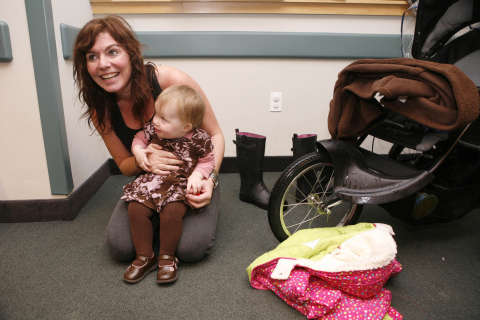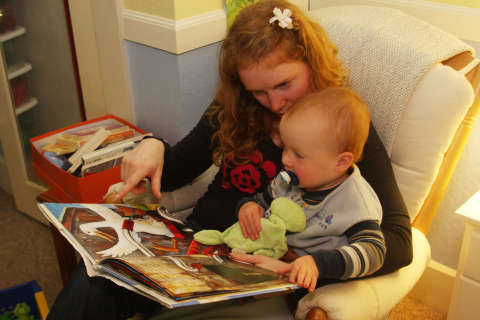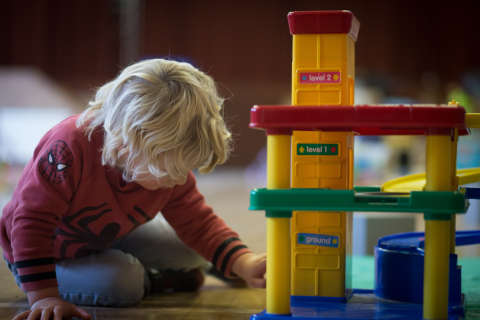The search for affordable, convenient, quality child care is a struggle in the Washington region. The five-part series Child Care Crisis will look at why it’s so hard to find care, and why costs are surpassing college tuition rates. The reports also examine the emotional toll the lack of child care takes on families.
WASHINGTON — Like nearly half of two-parent families in the U.S., Willis and Kristin Shawver knew they would both return to their full-time jobs shortly after the birth of their first child.
Finding someone to watch their baby while they went to the office became an all-consuming task. The Shawvers, from Arlington, Virginia, explored a few options, including a licensed in-home care provider. After a few calls around town, however, they abandoned that idea.
“It just seemed like the options weren’t great, and the timing was unclear as to when to really call in advance; not a lot of people had waitlists — it was just a confusing process,” said Kristin Shawver, who works at an economic consulting firm in Arlington.
They looked into a “nanny share” — splitting the cost of a nanny with another family. They searched for a family that lived close by, kept a similar schedule and had a child around the same age.
Willis Shawver, who works for a nonprofit development organization, compared the process to dating. The Shawvers were even “dumped” by one family before finding another that worked.
Then it was on to interviewing potential caregivers, agreeing on a salary and drawing up a contract that included vacation time, sick days and tax codes.
Each family paid the caregiver $500 a week, or $26,000 a year ($52,000 in total). That is only slightly above the average annual cost of infant care in D.C., $22,658, according to the nonprofit advocacy organization Child Care Aware of America.
The average salary of a nanny in the D.C. area is between $18 and $20 an hour, or $37,000 to $41,600 a year for a nanny who works a 40-hour workweek.
“I don’t know how people pay for a whole nanny themselves,” Kristin Shawver said. “We were willing to pay that for the extra care for the first year and peace of mind. But we were done after a year.”
Since the nanny share, their daughter, who is almost 3, is in her third child-care setting — an all-day preschool that costs $350 a week. The couple is expecting another child in March and already have care lined up for the new baby.
The second time around was a bit easier: They knew how to navigate the complex and confusing child-care system.
“It’s the most stressful thing about parenting,” Kristin said.
Stretched and stressed
For many couples, finding out you’re going to have a baby is one of the happiest times — only to be followed by one of the most stressful.
“Very quickly after you get pregnant, people start to ask you: Have you gotten on a child care list? Have you found a nanny? Are you going to keep working?” said Leslie Morgan Steiner, who writes about parenting and issues facing American women today.
“You get grounded very fast.”
Only a quarter of two-parent American families have a dad who works full-time and a mom who stays home, down from nearly half in the 1970s, Pew Research Center reports. That makes child care in higher demand than ever before.
“By and large, the majority of parents in this country need to work, so having good, safe environments to take their kids every day is super-important,” said Kristin Schubert, managing director of the Healthy Children Portfolio at the public health-focused Robert Wood Johnson Foundation.
“It is hugely stressful if your child doesn’t have a good place to go every day. It wreaks havoc on your entire life,” she said.
But finding a good place to send your child is not an easy task.
For starters, there aren’t enough spaces at existing day cares for more babies — especially in the D.C. area. In 2015, the District had roughly 7,610 slots at licensed care providers for the city’s 22,000 children under the age of 3.
In Maryland and Virginia, some parents put their names on waiting lists as soon as they find out they are pregnant — even before.
For the lucky parents who secure care, the next hurdle is affordability.
The U.S. Department of Health and Human Services says for child care to be considered affordable, it should cost no more than 10 percent of a family’s income. But in 30 states and D.C., the average cost of infant, center-based child care is more expensive than college tuition — and new parents don’t have 18 years to save up for it.
While most parents can’t afford child care, or dedicate a large portion of their salary to pay for it, those providing that care in the D.C. area and around the country can’t afford to live.
Child care is one of the lowest-paying professional fields. The Economic Policy Institute reports the median hourly wage for child-care workers in the U.S. is $10.39, and that only 15 percent of those workers receive health benefits.
“Caregivers are earning poverty wages, and more than half of them are earning [so] little money that they actually qualify for food stamps, or Medicaid or some kind of public assistance,” said Brigid Schulte, co-author of The Care Report and director of Better Life Lab and The Good Life Initiative at the D.C.-based think tank New America.
All of this uncertainty comes at a critical time in children’s growth. Eighty-five percent of brain development occurs during the first three years of life. It’s when children learn to communicate, to move and to connect emotionally with others.
“It lays the foundation for all future learning,” Schulte said.
Without a national child care system, there are no national quality standards that providers are required to meet. Several states and local governments have taken it upon themselves to implement quality standards, but this information isn’t always readily available to parents.
“What we really have is a patchwork, fragmented pieces that don’t really fit together,” Schulte said. “And frankly, after we did a really deep dive into the research, it really isn’t working for anybody.”
The second report of Child Care Crisis looks at what’s causing the shortage of available care in the D.C. area.








